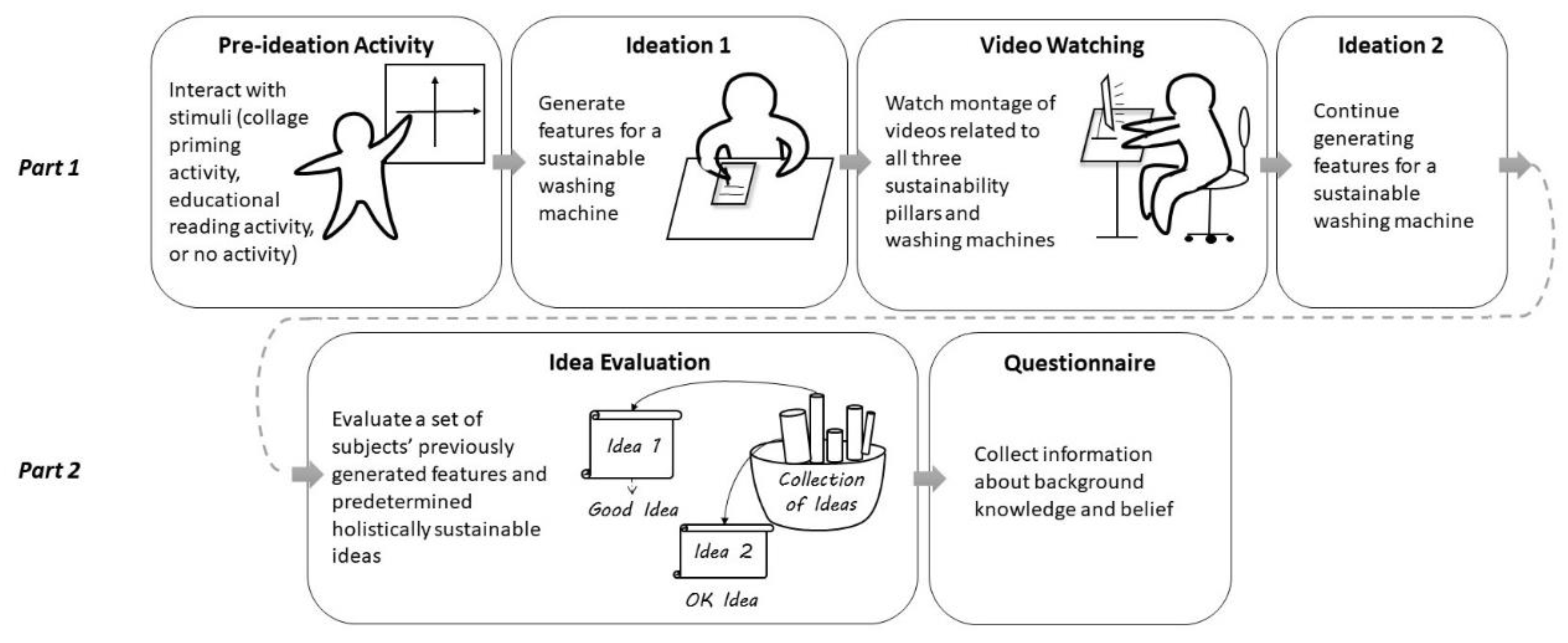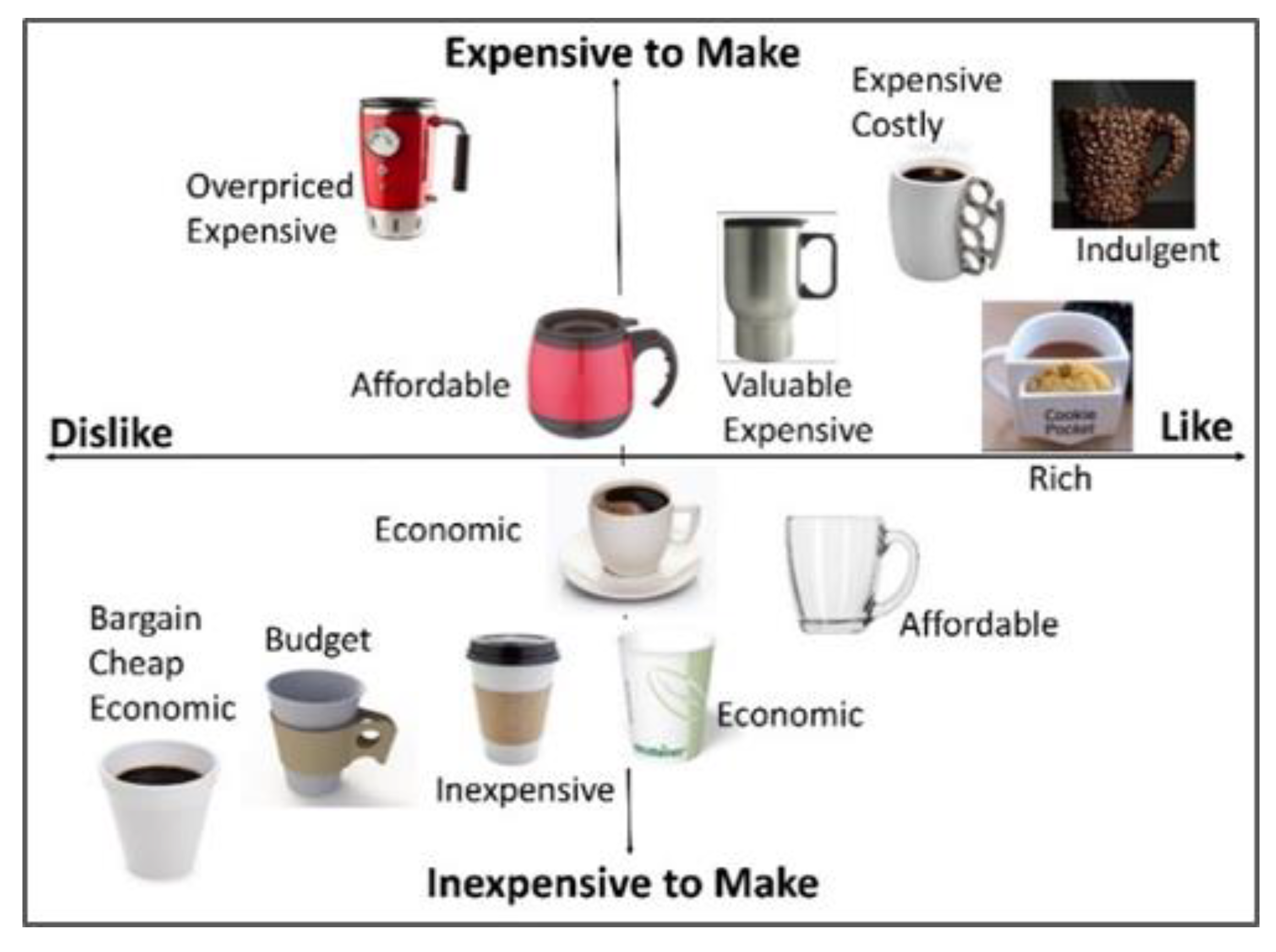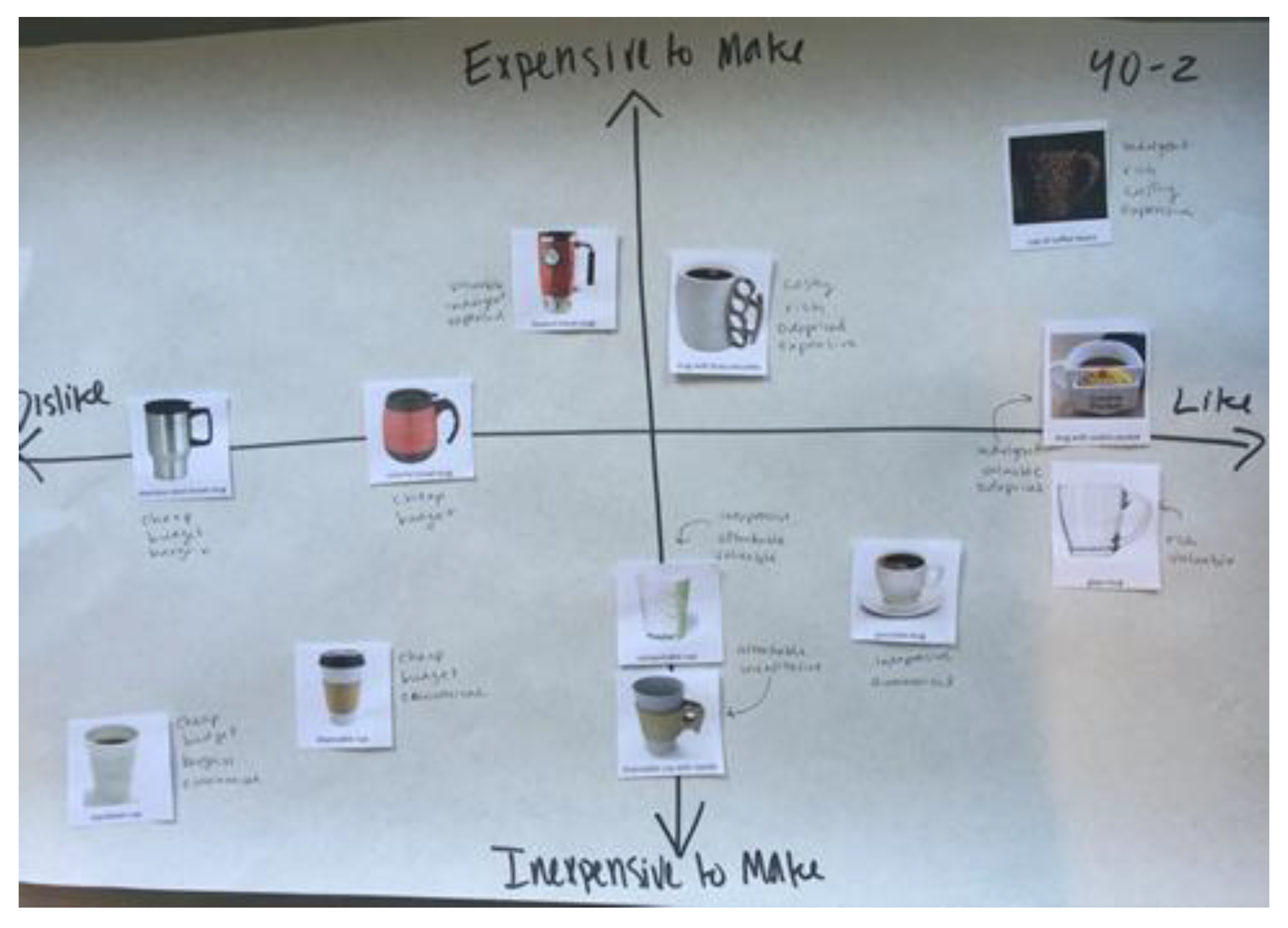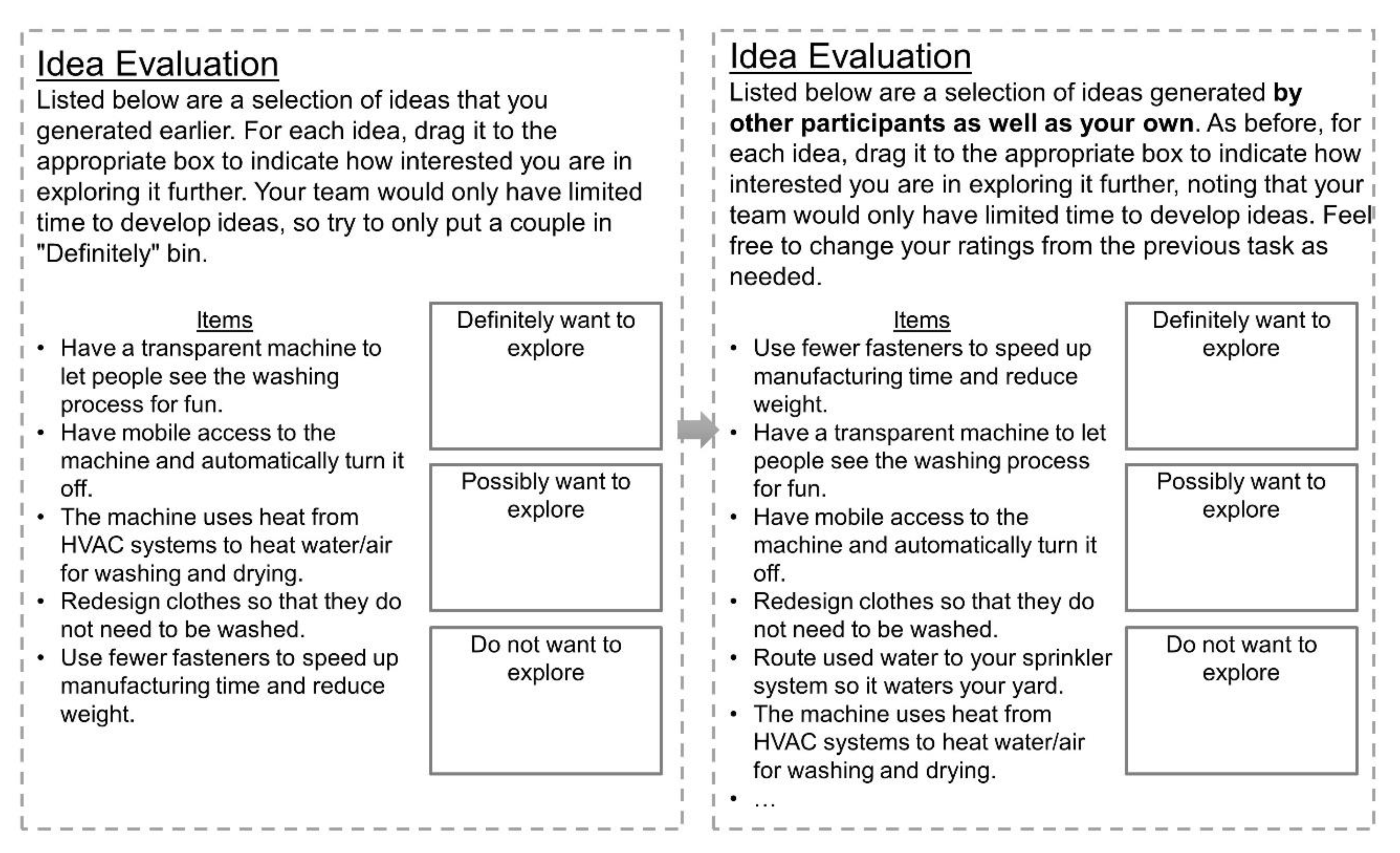Priming on Sustainable Design Idea Creation and Evaluation
Abstract
1. Introduction
2. Background
2.1. Sustainable Design and Framing of Sustainability
2.2. Priming Techniques
2.3. Cognitive Bias in Idea Evaluation
3. Research Propositions and Hypotheses
4. Method and Experiment Overview
- Pre-ideation Activity: Participants in conditions A1, A2, and A3 did the collage priming activity, and participants in condition B did the reading activity. Those in the control condition began in the next step, “Ideation 1.” The collage and reading activities are described in Section 5.1 and Section 5.2.
- Ideation 1: Participants generated design solutions for a washing machine.
- Video Watching: Participants watched a montage of videos that highlighted the sustainability aspects (user desirability, manufacturing, and environmental friendliness) of washing machines. This step was included to further stimulate design ideas, as described in Section 5.4.
- Ideation 2: Participants generated design solutions again for the same product.
- Idea Evaluation: Participants first evaluated a set of their own design ideas, classifying how interested they were in exploring each idea further. Then, they evaluated a mixed set of ideas, which included the same set of their ideas and a number of predetermined, sustainability-related ideas, presented as coming from other designers. The selection of those ideas and more details are described in Section 5.5. (Note that participants did not rate the relevance of design ideas regarding sustainability; this was performed later by expert judges.)
- Questionnaire: All participants filled out a questionnaire about their demographics, knowledge of sustainable design, and awareness of characteristics in sustainable design.
5. Activity and Stimuli Preparation and Description
5.1. Collage Priming Activity
5.1.1. Selecting of Products
5.1.2. Selection of Axes Labels
5.1.3. Selection of Descriptive Words
5.2. Reading Activity
5.3. Design Ideation
Imagine that you are working on a product design team at Smithfield Appliances, and you have been asked to design the next generation of sustainable washing machine. Product ideas may be related to reducing water and energy usage, improving manufacturing, and increasing the product’s appeal to users. Generate ideas that address this design challenge. You may use scratch paper if necessary but please type all individual ideas in the boxes below. You do not have to fill in all of the boxes. You will have 8 min to complete this task.
5.4. Video Montage
5.5. Idea Evaluation
6. Experiment Procedure
7. Data and Analysis of Proposition 1
7.1. Judging Preparation and Procedure
7.2. Idea Judging Results
8. Discussion of Proposition 1
9. Data and Analysis of Proposition 2
9.1. Bias Identification
9.2. Changing Attitude in Evaluation
10. Discussion of Proposition 2
11. Conclusion and Future Work
Author Contributions
Funding
Institutional Review Board Statement
Informed Consent Statement
Data Availability Statement
Conflicts of Interest
References
- Keeble, B.R. The Brundtland Report: Our Common Future. Med. War 1988, 4, 17–25. [Google Scholar] [CrossRef]
- Cuthill, M. Strengthening the ‘Social’ in Sustainable Development: Developing a Conceptual Framework for Social Sustainability in a Rapid Urban Growth Region in Australia. Sustain. Dev. 2010, 18, 362–373. [Google Scholar] [CrossRef]
- Littig, B.; Griessler, E. Social Sustainability: A Catchword between Political Pragmatism and Social Theory. Int. J. Sustain. Dev. 2005, 8, 65–79. [Google Scholar] [CrossRef]
- Pack, A.T.; Rose Phipps, E.; Mattson, C.A.; Dahlin, E.C. Social Impact in Product Design, An Exploration of Current Industry Practices. J. Mech. Des. 2020, 142. [Google Scholar] [CrossRef]
- Friedman, R.S.; Fishbach, A.; Förster, J.; Werth, L. Attentional Priming Effects on Creativity. Creat. Res. J. 2003, 15, 277–286. [Google Scholar]
- Stapel, D.A. Priming as Proxy: Understanding the Subjectivity of Social Life. In Cognitive Methods in Social Psychology; Klauer, K., Voss, A., Stahl, C., Eds.; Guilford Press: New York, NY, USA, 2011; pp. 148–183. [Google Scholar]
- Sassenberg, K.; Moskowitz, G.B. Don’t Stereotype, Think Different! Overcoming Automatic Stereotype Activation by Mindset Priming. J. Exp. Soc. Psychol. 2005, 41, 506–514. [Google Scholar] [CrossRef]
- Bruner, J.S. On Perceptual Readiness. Psychol. Rev. 1957, 64, 123. [Google Scholar] [CrossRef] [PubMed]
- She, J.; MacDonald, E.F. Priming Designers to Communicate Sustainability. ASME J. Mech. Des. 2014, 136, 011001. [Google Scholar] [CrossRef]
- Bargh, J.A.; Chen, M.; Burrows, L. Automaticity of Social Behavior: Direct Effects of Trait Construct and Stereotype Activation on Action. J. Personal. Soc. Psychol. 1996, 71, 230. [Google Scholar] [CrossRef]
- Erb, H.P.; Bioy, A.; Hilton, D.J. Choice Preferences WITHOUT Inferences: Subconscious Priming of Risk Attitudes. J. Behav. Decis. Mak. 2002, 15, 251–262. [Google Scholar] [CrossRef]
- Guyton, A.A. Developing Sustainable Product Semantics for Consumer Products: A Sustainable Designer’s Guide. Ph.D. Thesis, Georgia Institute of Technology, Atlanta, GA, USA, 2006. [Google Scholar]
- She, J.; MacDonald, E.F. Exploring the Effects of a Product’s Sustainability Triggers on Pro-Environmental Decision-Making. J. Mech. Des. 2018, 140. [Google Scholar] [CrossRef]
- She, J.; Seepersad, C.C.; Holtta-Otto, K.; MacDonald, E.F. Priming Designers Leads to Prime Designs. In Design Thinking Research; Springer: Basel, Switzerland, 2018; pp. 251–273. [Google Scholar]
- Onarheim, B.; Christensen, B.T. Distributed Idea Screening in Stage–Gate Development Processes. J. Eng. Des. 2012, 23, 660–673. [Google Scholar] [CrossRef]
- Ramani, K.; Ramanujan, D.; Bernstein, W.Z.; Zhao, F.; Sutherland, J.; Handwerker, C.; Choi, J.-K.; Kim, H.; Thurston, D. Integrated Sustainable Life Cycle Design: A Review. J. Mech. Des. 2010, 132. [Google Scholar] [CrossRef]
- Maxwell, D.; Van der Vorst, R. Developing Sustainable Products and Services. J. Clean. Prod. 2003, 11, 883–895. [Google Scholar] [CrossRef]
- Karlsson, R.; Luttropp, C. EcoDesign: What’s Happening? An Overview of the Subject Area of EcoDesign and of the Papers in this Special Issue. J. Clean. Prod. 2006, 14, 1291–1298. [Google Scholar] [CrossRef]
- Tischner, U.; Charter, M. Sustainable Product Design. In Sustainable Solutions: Developing Products and Services for the Future; Routledge: London, UK, 2001; Volume 22, p. 138. [Google Scholar]
- Ceschin, F.; Gaziulusoy, I. Evolution of Design for Sustainability: From Product Design to Design for System Innovations and Transitions. Des. Stud. 2016, 47, 118–163. [Google Scholar] [CrossRef]
- Halog, A.; Schultmann, F.; Rentz, O. Using Quality Function Deployment for Technique Selection for Optimum Environmental Performance Improvement. J. Clean. Prod. 2001, 9, 387–394. [Google Scholar] [CrossRef]
- Nielsen, P.H.; Wenzel, H. Integration of Environmental Aspects in Product Development: A Stepwise Procedure Based on Quantitative Life Cycle Assessment. J. Clean. Prod. 2002, 10, 247–257. [Google Scholar] [CrossRef]
- Lofthouse, V. Ecodesign Tools for Designers: Defining the Requirements. J. Clean. Prod. 2006, 14, 1386–1395. [Google Scholar] [CrossRef]
- De Benedetto, L.; Klemeš, J. The Environmental Performance Strategy Map: An Integrated LCA Approach to Support the Strategic Decision-Making Process. J. Clean. Prod. 2009, 17, 900–906. [Google Scholar] [CrossRef]
- Seuring, S.; Gold, S. Sustainability Management beyond Corporate Boundaries: From Stakeholders to Performance. J. Clean. Prod. 2013, 56, 1–6. [Google Scholar] [CrossRef]
- Gaziulusoy, A.I. A Critical Review of Approaches Available for Design and Innovation Teams through the Perspective of Sustainability Science and System Innovation Theories. J. Clean. Prod. 2015, 107, 366–377. [Google Scholar] [CrossRef]
- Grunert, K.G.; Hieke, S.; Wills, J. Sustainability Labels on Food Products: Consumer Motivation, Understanding and Use. Food Policy 2014, 44, 177–189. [Google Scholar] [CrossRef]
- Castillo, L.G.; Diehl, J.C.; Brezet, J.C. Design Considerations for Base of the Pyramid (BoP) Projects. In Proceedings of the Nothern World Mandate: Culumus Helsinki Conference, Helsinki, Finland, 24–26 May 2012; pp. 24–26. [Google Scholar]
- Mota, B.; Gomes, M.I.; Carvalho, A.; Barbosa-Povoa, A.P. Towards Supply Chain Sustainability: Economic, Environmental and Social Design and Planning. J. Clean. Prod. 2015, 105, 14–27. [Google Scholar] [CrossRef]
- Finkbeiner, M.; Schau, E.M.; Lehmann, A.; Traverso, M. Towards Life Cycle Sustainability Assessment. Sustainability 2010, 2, 3309–3322. [Google Scholar] [CrossRef]
- Gale, B.; Gale, B.T.; Wood, R.C. Managing Customer Value: Creating Quality and Service that Customers Can See; Simon and Schuster: New York, NY, USA, 1994. [Google Scholar]
- Mandel, N.; Johnson, E.J. When Web Pages Influence Choice: Effects of Visual Primes on Experts and Novices. J. Consum. Res. 2002, 29, 235–245. [Google Scholar] [CrossRef]
- Merikle, P.M.; Smilek, D.; Eastwood, J.D. Perception without Awareness: Perspectives from Cognitive Psychology. Cognition 2001, 79, 115–134. [Google Scholar] [CrossRef]
- Schacter, D.L. Priming and Multiple Memory Systems: Perceptual Mechanisms of Implicit Memory. J. Cogn. Neurosci. 1992, 4, 244–256. [Google Scholar] [CrossRef] [PubMed]
- Tulving, E.; Schacter, D.L. Priming and Human Memory Systems. Science 1990, 247, 301–306. [Google Scholar] [CrossRef] [PubMed]
- Collins, A.M.; Loftus, E.F. A Spreading-Activation Theory of Semantic Processing. Psychol. Rev. 1975, 82, 407. [Google Scholar] [CrossRef]
- Custers, R.; Aarts, H. The Unconscious Will: How the Pursuit of Goals Operates Outside of Conscious Awareness. Science 2010, 329, 47–50. [Google Scholar] [CrossRef]
- Shariff, A.F.; Norenzayan, A. God is Watching You: Priming God Concepts Increases Prosocial Behavior in an Anonymous Economic Game. Psychol. Sci. 2007, 18, 803–809. [Google Scholar] [CrossRef]
- Pfeffer, J.; DeVoe, S.E. Economic Evaluation: The Effect of Money and Economics on Attitudes about Volunteering. J. Econ. Psychol. 2009, 30, 500–508. [Google Scholar] [CrossRef]
- Kay, A.C.; Wheeler, S.C.; Bargh, J.A.; Ross, L. Material Priming: The Influence of Mundane Physical Objects on Situational Construal and Competitive Behavioral Choice. Organ. Behav. Hum. Decis. Process. 2004, 95, 83–96. [Google Scholar] [CrossRef]
- Marsh, R.L.; Bink, M.L.; Hicks, J.L. Conceptual Priming in a Generative Problem-Solving Task. Mem. Cogn. 1999, 27, 355–363. [Google Scholar] [CrossRef]
- Reed, A.; Aquino, K.; Levy, E. Moral Identity and Judgments of Charitable Behaviors. J. Mark. 2007, 71, 178–193. [Google Scholar] [CrossRef]
- Rietzschel, E.F.; Nijstad, B.A.; Stroebe, W. Relative Accessibility of Domain Knowledge and Creativity: The Effects of Knowledge Activation on the Quantity and Originality of Generated Ideas. J. Exp. Soc. Psychol. 2007, 43, 933–946. [Google Scholar] [CrossRef]
- Srull, T.K.; Wyer, R.S. The Role of Category Accessibility in the Interpretation of Information about Persons: Some Determinants and Implications. J. Personal. Soc. Psychol. 1979, 37, 1660. [Google Scholar] [CrossRef]
- Berger, J.; Meredith, M.; Wheeler, S.C. Contextual Priming: Where People Vote Affects How They Vote. Proc. Natl. Acad. Sci. USA 2008, 105, 8846–8849. [Google Scholar] [CrossRef]
- Lewis, S.; Dontcheva, M.; Gerber, E. Affective Computational Priming and Creativity. In Proceedings of the SIGCHI Conference on Human Factors in Computing Systems, Vancouver, BC, Canada, 7–12 May 2011; pp. 735–744. [Google Scholar]
- Galinsky, A.D.; Moskowitz, G.B. Counterfactuals as Behavioral Primes: Priming the Simulation Heuristic and Consideration of Alternatives. J. Exp. Soc. Psychol. 2000, 36, 384–409. [Google Scholar] [CrossRef]
- Lindley, J.; Wynn, L. Decision Making in Product Design–Bridging the Gap Between Inception and Reality. Des. Technol. Educ. Int. J. 2018, 23, 74–85. [Google Scholar]
- Nikander, J.B.; Liikkanen, L.A.; Laakso, M. The Preference Effect in Design Concept Evaluation. Des. Stud. 2014, 35, 473–499. [Google Scholar] [CrossRef]
- Jansson, D.G.; Smith, S.M. Design fixation. Des. Stud. 1991, 12, 3–11. [Google Scholar] [CrossRef]
- Moreno, D.P.; Yang, M.C.; Hernández, A.A.; Linsey, J.S.; Wood, K.L. A Step Beyond to Overcome Design Fixation: A Design-by-Analogy Approach. In Design Computing and Cognition’14; Springer: Basel, Switzerland, 2015; pp. 607–624. [Google Scholar]
- Burke, A. Neutralizing Cognitive Bias: An Invitation to Prosecutors. NYU J. Law Lib. 2006, 2, 512. [Google Scholar]
- Nickerson, R.S. Confirmation Bias: A Ubiquitous Phenomenon in Many Guises. Rev. Gen. Psychol. 1998, 2, 175–220. [Google Scholar] [CrossRef]
- Hallihan, G.M.; Shu, L.H. Considering Confirmation Bias in Design and Design Research. J. Integr. Des. Process Sci. 2013, 17, 19–35. [Google Scholar] [CrossRef]
- Tversky, A.; Kahneman, D. Judgment under Uncertainty: Heuristics and Biases. Judgm. Decis. Mak. Interdiscip. Read. 1986, 38–55. [Google Scholar]
- Viswanathan, V.; Linsey, J. Designing with Examples: A Study on the Role of Familiarity, Warnings and Physical Modelling. J. Eng. Des. 2020, 31, 552–573. [Google Scholar] [CrossRef]
- Cialdini, R.B.; De Nicholas, M.E. Self-Presentation by Association. J. Personal. Soc. Psychol. 1989, 57, 626. [Google Scholar] [CrossRef]
- Kahneman, D.; Knetsch, J.L.; Thaler, R.H. Experimental Tests of the Endowment Effect and the Coase Theorem. J. Political Econ. 1990, 98, 1325–1348. [Google Scholar] [CrossRef]
- Alicke, M.D. Global Self-Evaluation as Determined by the Desirability and Controllability of Trait Adjectives. J. Personal. Soc. Psychol. 1985, 49, 1621. [Google Scholar] [CrossRef]
- Toh, C.A.; Patel, A.H.; Strohmetz, A.A.; Miller, S.R. My Idea is Best! Ownership Bias and its Influence on Engineering Concept Selection. In Proceedings of the ASME 2015 International Design Engineering Technical Conferences and Computers and Information in Engineering Conference, Boston, MA, USA, 2–5 August 2015. [Google Scholar]
- Pugh, S. Total Design: Integrated Methods for Successful Product Engineering; Addison-Wesley: Boston, MA, USA, 1991. [Google Scholar]
- López-Mesa, B.; Bylund, N. A Study of the Use of Concept Selection Methods from Inside a Company. Res. Eng. Des. 2011, 22, 7–27. [Google Scholar] [CrossRef]
- McCusker, C.G. Cognitive Biases and Addiction: An Evolution in Theory and Method. Addiction 2001, 96, 47–56. [Google Scholar] [CrossRef] [PubMed]
- Ecodesign Overview. Available online: https://stanford.box.com/s/oa3vg1193ia0lkvjc9fs17czr04eaxsa (accessed on 30 March 2021).
- Yang, M.C. Observations on Concept Generation and Sketching in Engineering Design. Res. Eng. Des. 2009, 20, 1–11. [Google Scholar] [CrossRef]
- Reeves, C.A.; Bednar, D.A. Defining Quality: Alternatives and Implications. Acad. Manag. Rev. 1994, 19, 419–445. [Google Scholar] [CrossRef]
- Shah, J.J.; Smith, S.M.; Vargas-Hernandez, N. Metrics for Measuring Ideation Effectiveness. Des. Stud. 2003, 24, 111–134. [Google Scholar] [CrossRef]
- Kudrowitz, B.M.; Wallace, D. Assessing the Quality of Ideas from Prolific, Early-Stage Product Ideation. J. Eng. Des. 2013, 24, 120–139. [Google Scholar] [CrossRef]
- Santos, J.R.A. Cronbach’s Alpha: A Tool for Assessing the Reliability of Scales. J. Ext. 1999, 37, 1–5. [Google Scholar]
- Nachar, N. The Mann-Whitney U: A Test for Assessing Whether Two Independent Samples come from the Same Distribution. Tutor. Quant. Methods Psychol. 2008, 4, 13–20. [Google Scholar] [CrossRef]
- Starkweather, J.; Moske, A.K. Multinomial Logistic Regression. 2011, pp. 2825–2830. Available online: http://www.unt.edu/rss/class/Jon/Benchmarks/MLR_JDS_Aug2011.pdf (accessed on 10 September 2019).
- Haneuse, S.; Bartell, S. Designs for the Combination of Group-and Individual-Level Data. Epidemiology 2011, 22, 382. [Google Scholar] [CrossRef]
- Wilcoxon, F.; Katti, S.K.; Wilcox, R.A. Critical Values and Probability Levels for the Wilcoxon Rank Sum Test and the Wilcoxon Signed Rank Test. Sel. Tables Math. Stat. 1970, 1, 171–259. [Google Scholar]
- Idemat. Available online: http://idematapp.com/#home (accessed on 20 April 2021).





| User Desirability | Cost | Environmental | |
|---|---|---|---|
| Horizontal axis labels | Dislike/Like | Dislike/like | Dislike/Like |
| Vertical axis labels | Boring/ Delightful | Inexpensive/ Expensive to make | Low/High environmental impact |
| Collage words | Sociable | Affordable | Recyclable |
| Friendly | Budget | Natural | |
| Warm | Cheap | Efficient | |
| Helpful | Economical | Organic | |
| Ergonomic | Bargain | Conserving | |
| Modern | Valuable | Polluting | |
| Unfriendly | Inexpensive | Disposable | |
| Useless | Indulgent | Synthetic | |
| Useful | Overpriced | Inefficient | |
| Solitary | Expensive | Wasteful | |
| Playful | Rich | Reusable | |
| Stylish | Costly | Consumable |
| Rating Category | Description of Score 1 | Description of Score 3 | Description of Score 5 |
|---|---|---|---|
| Originality | Not expressed before and ingenious | Not typical, and show some imagination | Common and boring |
| Feasibility | Easy to implement without major changes or violation of known constraints (financially and physically) | Could be implemented with minor changes to existing conditions | Very hard to implement given the existing conditions and/or requiring significant research and development |
| User Desirability | Manufacturing Cost | Use Cost | Environmental Impact | |
|---|---|---|---|---|
| % Agreement | 72.9 | 92.0 | 66.6 | 64.9 |
| Cronbach’s α | 0.75 | 0.82 | 0.70 | 0.72 |
| User Desirability | Manufacturing Cost | Use Cost | Environmental Impact | |
|---|---|---|---|---|
| % Agreement | 81.2 | 96.0 | 81.2 | 76.0 |
| Cronbach’s α | 0.91 | 0.95 | 0.90 | 0.89 |
| Feasibility | Originality | |
|---|---|---|
| % Agreement | 66.3 | 55.0 |
| Cronbach’s α | 0.56 | 0.41 |
| Feasibility | Originality | |
|---|---|---|
| % Agreement | 81.5 | 74.9 |
| Cronbach’s α | 0.72 | 0.61 |
| Condition | Number of Participants | Total Number of Ideas Generated (Including Non-Unique Ones) | Average Number of Ideas Generated Per Participant |
|---|---|---|---|
| User desirability prime (A1) | 13 | 159 | 12.2 |
| Cost prime (A2) | 15 | 195 | 13.0 |
| Environmental prime (A3) | 16 | 191 | 11.9 |
| Reading (B) | 14 | 204 | 14.6 |
| Control (C) | 15 | 165 | 11.0 |
| Total | 73 | 914 | 12.5 |
| Condition | Rating Category | |||||
|---|---|---|---|---|---|---|
| Relevance to Sustainability-Related Aspects (Scale 0–2) | Quality (Scale 1–5) | |||||
| User Desirability | Manufacturing Cost | Use Cost | Environmental Impact | Originality | Feasibility | |
| User desirability prime (A1) | 0.846 (0.895) | 0.164 (0.924) | 0.745 (0.768) | 1.30 (0.026 *) | 2.55 (0.035 *) | 3.22 (0.116) |
| Cost prime (A2) | 0.585 (0.008 *) | 0.159 (0.885) | 0.764 (0.920) | 1.26 (0.057) | 2.60 (0.067) | 3.23 (0.039 *) |
| Environmental prime (A3) | 0.679 (0.115) | 0.145 (0.794) | 0.844 (0.424) | 1.32 (0.012 *) | 2.61 (0.095) | 3.26 (0.021 *) |
| Reading (B) | 0.544 (0.004 *) | 0.259 (0.072) | 0.724 (0.751) | 1.31 (0.019 *) | 2.64 (0.163) | 3.13 (0.382) |
| Control (C) | 0.830 | 0.161 | 0.774 | 1.07 | 2.77 | 3.03 |
| Grand Mean | 0.685 | 0.180 | 0.767 | 1.26 | 2.64 | 3.18 |
| Factor | Prime | Source | Relevance to User Desirability | Relevance to Manufacturing Cost |
|---|---|---|---|---|
| 2 | 1.20 (0.980) | 33.6 (0.000 *) | 11.4 (0.003 *) | 7.41 (0.025 *) |
| Factor | Relevance to Use Cost | Relevance to Environmental Impact | Originality | Feasibility |
| 2 | 6.18 (0.045 *) | 35.3 (0.000 *) | 20.26 (0.000 *) | 1.41 (0.495) |
| Source | Relevance to Sustainability-Related Aspects | Quality | |||||
|---|---|---|---|---|---|---|---|
| User Desirability | Use Cost | Manufacturing Cost | Environmental Impact | Originality | Feasibility | ||
| A1 | 1.91 (0.385) | 6.76 (0.034 *) | 2.62 (0.270) | 3.39 (0.184) | 15.5 (0.000 *) | 9.32 (0.009 *) | 0.390 (0.823) |
| A2 | 17.3 (0.000*) | 1.32 (0.517) | 0.522 (0.770) | 2.01 (0.366) | 5.21 (0.074) | 0.683 (0.711) | 3.26 (0.196) |
| A3 | 13.2 (0.001 *) | 0.035 (0.983) | 4.51 (0.105) | 1.52 (0.467) | 8.91 (0.012 *) | 5.83 (0.054) | 0.640 (0.726) |
| B | 1.99 (0.370) | 3.34 (0.188) | 3.77 (0.152) | 1.62 (0.444) | 6.54 (0.038 *) | 6.87 (0.032 *) | 0.752 (0.686) |
| C | 8.17 (0.017 *) | 7.65 (0.022 *) | 2.36 (0.308) | 0.669 (0.716) | 0.80 (0.055) | 0.094 (0.954) | 5.33 (0.070 *) |
| Condition | Test Statistics |
|---|---|
| User desirability prime (A1) | 36 (0.03 *) |
| Cost prime (A2) | 30 (0.09) |
| Environmental prime (A3) | 140 (0.20) |
| Reading (B) | 100 (0.90) |
| Control (C) | 70 (0.50) |
Publisher’s Note: MDPI stays neutral with regard to jurisdictional claims in published maps and institutional affiliations. |
© 2021 by the authors. Licensee MDPI, Basel, Switzerland. This article is an open access article distributed under the terms and conditions of the Creative Commons Attribution (CC BY) license (https://creativecommons.org/licenses/by/4.0/).
Share and Cite
Liao, T.; MacDonald, E.F. Priming on Sustainable Design Idea Creation and Evaluation. Sustainability 2021, 13, 5227. https://doi.org/10.3390/su13095227
Liao T, MacDonald EF. Priming on Sustainable Design Idea Creation and Evaluation. Sustainability. 2021; 13(9):5227. https://doi.org/10.3390/su13095227
Chicago/Turabian StyleLiao, Ting, and Erin F. MacDonald. 2021. "Priming on Sustainable Design Idea Creation and Evaluation" Sustainability 13, no. 9: 5227. https://doi.org/10.3390/su13095227
APA StyleLiao, T., & MacDonald, E. F. (2021). Priming on Sustainable Design Idea Creation and Evaluation. Sustainability, 13(9), 5227. https://doi.org/10.3390/su13095227





